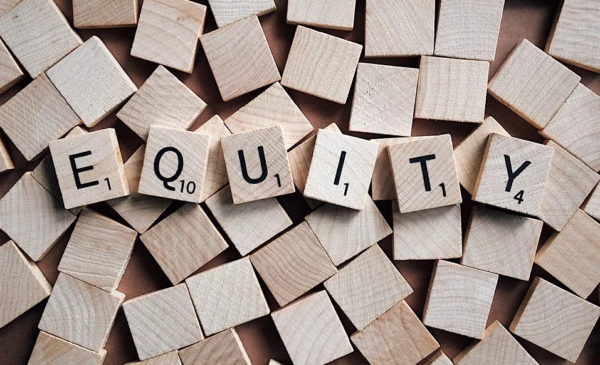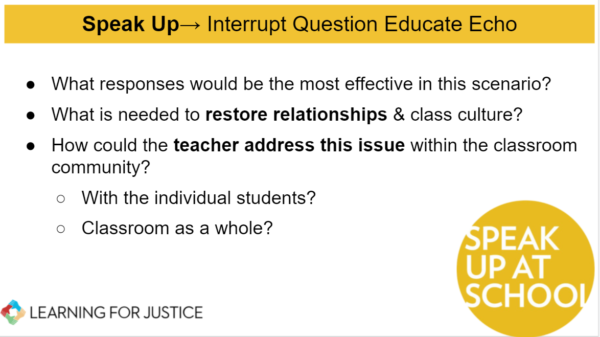Equity Advisory Committee
I recently helped design and lead a district wide PD on equity. A mandatory staff training of this breadth hasn’t been done in close to a decade, let alone a training focused on equity, so our work was cut out for us.
The impetus for the training came from our district’s Equity Advisory Committee (EAC), a group of teachers, parents, and leaders who’ve volunteered to assess our district’s equity policy and practices.
Our teaching staff is 93.9 % white so talking about issues of equity and race is difficult, to say the least. But, this group has been collaborative space to surface issues of discrimination, bias, and inequity.
Parents have been vocal and vulnerable. One in particular shared how her son was called the n-word by another student repeatedly, and chose to transfer schools because he didn’t feel safe, let alone really seen.
Educators have articulated their frustration with equity work that seems to move at a glacial pace.

Speak Up At School
Our superintendent’s initial plan for this mandatory equity training focused on Harassment, Intimidation, and Bullying (HIB). While that work is critical, our equity leaders worried that centering on HIB would be an easy excuse for white people to once again avoid talking about race and simply focus on colorblind kindness
Knowing this, we reflected on what we’ve done in our building to design a training using the Speak Up At School framework from Learning for Justice.
We started the session with an overview of the resources and we then moved into breakout rooms where people discussed scenarios that have happened in our buildings using the Interrupt, Question, Educate, and Echo pocket guide.

Although we’d hear some complaints later, as we always do with anything labeled “equity,” it seemed to be going well. The conversations in the breakout rooms I visited were productive and people came back to share thoughtful insights with the larger group.
It was going well until the last two minutes, that is.when an older white man, let’s call him George, asked why we can’t just go back to the times of Martin Luther King when we celebrated everyone, regardless of their skin color. He said he doubted that MLK would even have supported Black Lives Matter.
And, just like that, a relatively successful training crumbled. My principal offered redirection and a few tried to point out the flaws in his thinking. But, others echoed George and quickly the chat spiraled into a political debate that luckily could be severed by an “end meeting” button.
The next week, when I saw colleagues in the hall, they were just as likely to thank me as they were to cringe about what George said.
Later, we found out that one of the few staff members of color ended up leaving the meeting, rightfully discouraged by how colleagues debated the validity of her lived experience.
Equity 101
I can’t and don’t blame her because I too was incredibly frustrated, and I have the privilege of being white.The fact that a training we had worked on for weeks could be so easily derailed easily was disheartening, but not exactly surprising.
Having so many different staff members together was a glaring reminder that we don’t all need the same training. Teachers differentiate for a reason. Some students need sentence stems to start an essay, while others dive into symbolism with college level prose. We meet students where they are and we need to do the same for adults.
The EAC was clear: equity work (education and training for tangible change) has to be mandatory. As soon as “equity” is optional, educators will choose to check out. It’s up to leadership to find the best ways to invite everyone to this work, otherwise, nothing will change.
Our staff of color might need affinity groups, so they don’t have to hear the George’s of the world catch up to 2021. And, maybe George needs a safe space, perhaps with other white males, where he can ask questions and get some more accurate answers without committing an abuse against the marginalized.
What would it look like to have an equity 101 course in our August staff development, along with a 201, 301, and even graduate level? What would it look like to have these ongoing conversations all year? Not just in “equity” allocated PD days, but in all of what we do?
This training we started has to be the floor, not the ceiling.
Yes, Even (Especially) White People
A few weeks later, I saw George at a sporting event and he thanked me for “that equity thing.” He said it was good stuff but “it’s hard because, you know, we don’t have a lot of…*insert awkward hand motions to wave around the fact that we are 93.9% white.*”
I tried to call out what he was dancing around and said something like, “Yes, it is challenging to have these discussions with a majority white staff, but the work is still important.”
Hindsight, I wish I had added something like, “As white folks, we have to confront our own biases and reflect on how our norms can be harmful. We need to act to interrupt systems of white supremacy and inequity.”
But, in reality, if I said that, he probably would have shut down. George is a good reminder to me of the need for “Equity 101” and staff differentiation. He means well and it seems he wants to learn, so the only thing worse than his training comments would be for him to stop listening and engaging altogether.
We might be in different places on our equity journeys, but it’s important that we keep our foot on the gas.
Pingback: Constructing Equitable Schools: One Block at a Time | Stories From School
Pingback: Student Equity Summit | Stories From School
What you are describing is exactly my experience as well. All it takes is one Georgecomment and people exhale and step back into their comfortable old biases like a familiar pair of shoes.
AND the delicate dance we have to do, especially as white educators, is to find the way to convey our messages so that fellow white educators don’t pivot back into their more comfortable position of looking away from reality. I’ve struggled with wanting to keep my foot on the gas (the situation is urgent) while keeping everyone one the bus. It is just way to easy for white teachers to say “huh, not my problem, I’ve never experienced that…” and go back to just grading papers…
This is such a relatable blog. You are so right to say that we have to meet our “students” where we are. However, like many of us, I am tired of “Equity 101” being the peak of our work in the district. We need the next level, even though some of us are struggling with the basics.